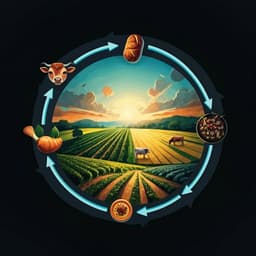
Earth Sciences
Quantifying Earth system interactions for sustainable food production via expert elicitation
A. Chrysafi, V. Virkki, et al.
This groundbreaking paper sheds light on the complex interactions among Earth system processes impacting food production. Through expert knowledge elicitation, the research reveals overlooked connections, particularly the influence of green water and land system changes. Conducted by a team of experts, it paves the way for enhanced Earth system modeling and defines biophysical limits for sustainable food production.
~3 min • Beginner • English
Introduction
The study addresses how interactions among critical Earth system processes relevant to food production influence the safe operating space for humanity. Food production is a dominant driver of environmental impacts (biodiversity loss, eutrophication, freshwater use, deforestation) and several planetary boundaries have likely been transgressed. Prior work has begun to quantify some interactions among planetary boundary processes, but many interactions—especially those involving marine systems and components directly tied to food production—remain unquantified. Interactions are difficult to include in spatially explicit models due to context dependence and data gaps. The authors focus on four Earth system processes pertinent to food production—biogeochemical flows, biosphere integrity (split into land, freshwater, and ocean components), freshwater use (split into blue and green water), and land system change—represented by seven control variables. They aim to map and quantify local-scale direct biophysical interactions and their mechanisms via structured expert elicitation to inform sustainable food production and refine understanding of safe operating spaces.
Literature Review
The paper builds on the planetary boundaries framework and recent literature quantifying limited subsets of interactions among Earth system processes. Previous studies suggest amplifying cascades and feedbacks can narrow the safe operating space, while synergies may exist when pressures are reduced. However, interactions relevant to food production, especially involving marine processes, have been underexplored. Model-based quantifications exist but are typically restricted to a few processes due to complexity and computational demands. The authors compare their expert-elicited interaction strengths with prior quantitative estimates for a subset of interactions and find agreement in directions and broadly in relative strengths, noting differences due to normalization, control variables, and spatial scales. The review underscores the need for more comprehensive, cross-domain, and scale-bridging assessments of interactions, including green water and aquatic biodiversity components within the biosphere integrity boundary.
Methodology
Design: A structured expert knowledge elicitation was conducted using the IDEA protocol (investigate, discuss, estimate, aggregate), featuring two anonymous elicitation rounds with a moderated pseudonymous discussion in between.
Control variables: Seven local-scale control variables were defined: (1) BI land: Biodiversity Intactness Index (BII); (2) BI freshwater: biomass of keystone fish species (relative to carrying capacity K); (3) BI ocean: biomass of keystone fish species; (4) Land system change: forested land area relative to potential forest cover; (5) Biogeochemical flows: leached inorganic nitrogen concentration in runoff to surface waters (mg N l−1); (6) Blue water: seasonal river discharge relative to pre-industrial (separate high-flow and low-flow seasons); (7) Green water: growing-season root-zone soil moisture relative to pre-industrial.
Scenario and scope: Experts evaluated direct local interactions in a hypothetical 100 km² area with all control variables initially within locally safe ranges. A scenario-based approach enabled consistent baselines and consideration of state dependence. Experts could choose regional contexts for their answers if desired.
Participants and recruitment: 231 candidates were invited (200 literature-identified plus 31 via snowballing); 37 experts completed the full process, providing 5–19 responses per identified interaction. Expertise spanned the selected Earth system processes and planetary boundaries.
Elicitation procedure: For each potential directed interaction X→Y, experts provided lower/upper plausible values, a best estimate, and a confidence interval for how a change ΔX would alter Y. Inputs were given only where experts felt qualified. The web-based Shiny application provided all materials and collected responses.
Aggregation: Individual responses were standardized to 100% CI, then fitted with PERT distributions (from lower, best, upper). Aggregation used unweighted medians (quantile aggregation) of non-region-specific and statistically consistent region-specific responses. Similarity of region-specific to aggregated non-region distributions was evaluated via Kullback–Leibler divergence; sufficiently similar region-specific distributions were included. Aggregated values (lower, best, upper) at 80% CI were derived for each interaction.
Normalization and interaction strength: Control variables were normalized relative to theoretical natural states. Absolute normalized interaction strength s for X→Y was computed as s = Δy/Δx in normalized units, using only direct interactions to avoid double-counting. Because nitrogen increases with degradation whereas other variables decrease, signs for biogeochemical interactions were treated carefully; results emphasize amplifying vs attenuating direction rather than numeric sign. Uncertainty categorization considered expert agreement and number of responses per interaction.
Outputs: Identified interactions, their normalized strengths (0–1 scale), net originating vs receiving strengths per control variable, a network of mediating mechanisms from qualitative inputs, and a prioritization scheme combining strength and uncertainty to guide future research.
Key Findings
- Coverage: Experts identified 37 direct biophysical interactions out of 54 possible among the seven control variables, indicating dense local interconnections.
- Impacted processes: The biosphere integrity components—especially aquatic (BI freshwater and BI ocean)—receive strong net impacts from other processes. BI freshwater is notably affected by blue water (both seasons), biogeochemical flows (nitrogen), and BI land.
- Originating processes: Green water (soil moisture) and land system change are strong originators of impacts on other processes. Declines in soil moisture directly affect blue water, BI land, and land system change; reduced forest cover decreases soil moisture, reinforcing feedbacks.
- Attenuation vs amplification: Most interactions are amplifying (degradation in one exacerbates degradation in others). Attenuating interactions are rare; the main example is land system change → blue water (local decreases in forest cover can increase river discharge), though at larger scales deforestation tends to reduce precipitation and discharge. A weak attenuating effect was noted for biogeochemical flows → land system change at low N (productivity boost), reversing to amplifying at higher N.
- Strength distribution: Seven interactions were extremely weak (<0.005) and excluded from prioritization; their weakness may be genuine or context-specific/complex.
- Consistency with literature: For seven interactions previously quantified globally, directions agreed and relative strengths were broadly similar, acknowledging differences in definitions and scales.
- Roles (net strengths): BI components largely on the receiving end; green water and land system change primarily originating; biogeochemical flows and blue water show balanced mediating roles.
- Mechanisms: A complex network of mediating mechanisms was mapped (for example, erosion links reduced forest cover/soil moisture to increased N loss and sediment, harming BI freshwater and BI ocean). Mechanisms can be counteracting and vary in timescales and context.
- Prioritization: Interactions that are strong but high-uncertainty or with disagreement on direction (for example, biogeochemical flows → BI freshwater/ocean; blue water → BI ocean) should be prioritized for research. Medium-uncertainty interactions involving BI components merit attention due to high overall impacts.
Discussion
The findings quantify and map how local-scale interactions among Earth system processes relevant to food production are predominantly amplifying, implying that degradation in one area can propagate to others and potentially narrow the safe operating space. Recognizing the strong originating roles of green water and land system change, and the high sensitivity of aquatic and terrestrial biodiversity components, highlights leverage points for management: actions that improve soil moisture or limit deforestation can produce co-benefits across multiple processes. The network of mechanisms provides pathways to identify synergistic interventions (e.g., erosion control, riparian/coastal habitat conservation, enhancing agroecosystem integrity) that can simultaneously alleviate pressure on biosphere integrity, hydrology, and nutrient flows. The results also help bridge local and global scales by informing how local safe operating spaces may need adjustment considering cross-process interactions. Incorporation of these interaction strengths and mechanisms into Earth system and food system models can improve assessments and avoid unintended consequences of single-issue policies. However, context dependence and temporal dynamics mean operationalization should be tailored regionally, supported by case-specific studies and validation.
Conclusion
This study contributes a comprehensive expert-elicited quantification of 37 local-scale interactions among seven control variables spanning key Earth system processes for food production, alongside a detailed mapping of mediating mechanisms. It identifies green water and land system change as major originators of impacts and biosphere integrity components—especially aquatic—as highly impacted receivers. The predominance of amplifying interactions underscores risks of cascading degradation but also points to synergistic opportunities where targeted actions yield multi-process benefits. The proposed prioritization scheme directs future research toward strong, uncertain, or directionally disputed interactions. Future work should: (1) perform regional and local validations using observational and model-based studies; (2) expand to additional elements (e.g., phosphorus) and processes (including climate interactions) and explore temporal scales; (3) integrate findings into coupled Earth system and food system models to improve policy-relevant assessments; and (4) refine local safe operating spaces accounting for interactions to guide sustainable food production.
Limitations
- Expert elicitation biases: Judgements can be influenced by heuristic biases, disciplinary backgrounds, and contextual experiences; experts were not performance-weighted or calibrated due to lack of suitable test questions.
- Sample size and coverage: 37 experts with 5–19 responses per interaction; some interactions had few responses, leading to higher uncertainty.
- Scenario constraints: Only one hypothetical scenario (all variables initially within safe ranges) was evaluated; results may differ under other baseline states.
- Context specificity: Mechanism dominance, interaction strengths, and even directions can vary by environment, scale, and time; aggregated results mask such heterogeneity.
- Normalization challenges: Especially for biogeochemical flows (nitrogen), where control variable behavior differs from others; sign conventions complicate interpretation outside the study’s framework.
- Model-free quantification: While directions and relative strengths align with literature, precise magnitudes should be used cautiously and ideally alongside model-based analyses.
Related Publications
Explore these studies to deepen your understanding of the subject.







